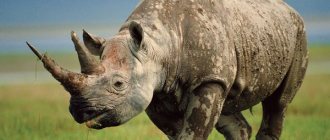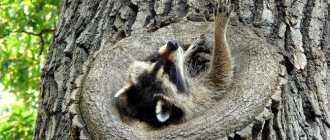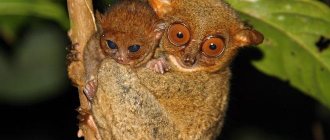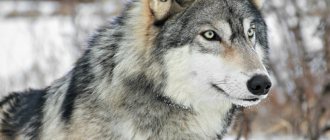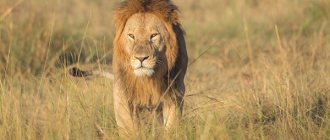Dimensions
The size of the tyrannosaurus is impressive. 12 meters long, 4 meters hip height, and about 7 tons in weight. The huge skull, seated with dozens of long teeth, could be 1.5-2 meters in length and completely accommodate a person. The teeth of a Tyrannosaurus rex are the absolute record holders among the teeth of all land predators. The length with the root reached 30 cm. Even the hypertrophied upper fangs of saber-toothed Smilodon were, although slightly, shorter.
The bite force of a Tyrannosaurus rex is many times greater than that of all modern predators. Of course, its reconstruction is not ideal and there will still be recalculations, but today we have impressive numbers: 250-300 kN. This makes Tyrannosaurus rex's jaws some of the most powerful in the history of land animals.
Hunter Skills
The question of whether the T. rex was a hunter or a scavenger has still not been resolved. But the set of progressive features of the tyrannosaurus is increasingly inclining paleontologists to a hunting lifestyle. Rex has well-developed binocular vision. Binocular vision is the ability to focus on an object with both eyes, which gives a more accurate estimate of distance. Such vision is more characteristic of active hunters than scavengers. The part of the Tyrannosaurus rex's brain responsible for smell is also well developed. You can say that this is characteristic of scavengers, but all carnivores have a good sense of smell: both carrion lovers and excellent hunters. Also, the tyrannosaurus has a strengthened jaw and deep-set teeth. Remarkably, the jaw has additional mobility relative to other tyrannosaurids, which provides increased stability under lateral loads. This adaptation is also more suitable for a hunter of large animals than for a scavenger, whose food does not resist and cannot damage the jaw. The jaws and teeth of the tyrannosaurus seem to be specially created to hold a resisting multi-ton victim. With its weight, the tyrannosaurus, of course, could not run after the victim, which is confirmed by recent studies, but it was quite capable of tracking. True, the tyrannosaurus had no need to run: its main diet was slow triceratops and hadrosaurs with a turning angle like a train. This is evidenced by intravital bite marks from giant jaws on the collars and tails of victims.
Behavior
Tyrannosaurs were extremely aggressive dinosaurs. This aggression also manifested itself within the species, which calls into question their social way of life. We can observe the struggle of giant theropods that lived 66 million years ago from almost complete skeletons (60-70% of the bones found relative to the complete skeleton). Adult tyrannosaurs such as Stan and Sue had a large number of lifetime injuries similar to bite marks. Perhaps such bites could be traces of a fight during the mating season. Female tyrannosaurs entered sexual maturity at 14-16 years of age, and the average lifespan of a T. rex was 30 years.
Range, habitats
The fossils were found in Maastrichtian deposits, revealing that Tyrannosaurus rex lived in the Late Cretaceous period from Canada to the United States (including the states of Texas and New Mexico). Curious specimens of the tyrant lizard were discovered in the northwestern United States in the Hell Creek Formation - during the Maastrichtian there were subtropics, with their excess heat and humidity, where coniferous trees (araucaria and metasequoia) were interspersed with flowering plants.
Important! Judging by the dislocation of the remains, the tyrannosaurus lived in various biotopes - arid and semi-arid plains, swampy areas, as well as on land remote from the sea.
Tyrannosaurs coexisted with herbivorous and carnivorous dinosaurs, such as:
- Triceratops;
- duck-billed edmontosaurus;
- Torosaurus;
- Ankylosaurus;
- thescelosaurus;
- Pachycephalosaurus;
- Ornithomimus and Troodon.
Another famous site of Tyrannosaurus rex skeletons is a geological formation in Wyoming that millions of years ago resembled an ecosystem similar to the modern Gulf Coast. The fauna of the formation practically repeated the fauna of Hell Creek, except that instead of Ornithomimus, Struthiomimus lived here, and Leptoceratops (a small representative of Ceratopsians) was also added.
In the southern sectors of its range, Tyrannosaurus rex shared territories with Quetzalcoatlus (a huge pterosaur), Alamosaurus, Edmontosaurus, Torosaurus, and one of the ankylosaurs called Glyptodontopelta. The south of the range was dominated by semi-arid plains that appeared here after the disappearance of the Western Inland Sea.
Return to content
Paws
Few dinosaur students don't like to discuss the purpose of Tyrannosaurus rex's legs. In fact, many theropods have vestigial forelimbs. Almost all tyrannosaurids, giganotosaurs, and carnotaurs are famous for this. The short legs of a tyrannosaurus could have been useful only at a very young age. If you have almost the most powerful jaws in the history of the Earth in your arsenal, the need for claws and powerful paws disappears by itself. From millennium to millennium, the forelimbs of the tyrannosaurus decreased until they reached such tiny sizes. If the king had lived a little longer, he might have lost them altogether.
Reproduction and offspring
Osborne, who reflected on the role of underdeveloped forelimbs, suggested in 1906 that they were used by tyrannosaurs during mating.
Almost a century later, in 2004, the Jurassic Museum of Asturias (Spain) placed in one of its halls a pair of tyrannosaurus skeletons caught in the act of sexual intercourse. For greater clarity, the composition was supplemented with a colorful picture covering the entire wall, where lizards are drawn in their natural form.
Interesting! Judging by the museum image, tyrannosaurs mated while standing: the female raised her tail and tilted her head almost to the ground, and the male took an almost vertical position behind her back.
Since females were larger and more aggressive than males, it took the latter a lot of effort to win over the former. The brides, although they called the grooms with a sonorous roar, were in no hurry to copulate with them, expecting generous gastronomic offerings in the form of weighty carcasses.
The intercourse was short, after which the gentleman left the impregnated partner, going in search of other ladies and provisions. A few months later, the female built a nest directly on the surface (which was extremely risky), laying 10–15 eggs there. To prevent the offspring from being devoured by egg hunters, for example, dromaeosaurs, the mother did not leave the nest for two months, protecting the clutch.
Paleontologists suggest that even in the best times for tyrannosaurs, no more than 3-4 newborns were born from the entire brood. And in the Late Cretaceous period, the reproduction of tyrannosaurs began to decline and completely stopped. The reason for the extinction of Tyrannosaurus rex is considered to be increased volcanic activity, due to which the atmosphere was filled with gases that had a destructive effect on the embryos.
Return to content
Tyrannosaurus as an icon of paleontology
It's no secret that the first animal that comes to mind when mentioning paleontology in general and dinosaurs in particular is the Tyrannosaurus rex. Books and films are dedicated to him. It attracts professionals with its adaptations, which its relatives do not have, and amateurs with its terrifying size. And it would seem that in the 21st century, when dozens of tyrannosaurs have already been found, including well-preserved ones, pressing issues should be resolved. But this is only a superficial look at the animal. Issues of hunting, behavior, skin are still relevant. The Tyrannosaurus rex became the main antagonist in Michael Crichton's book Jurassic Park, and later in the films. T-Rex impressed the audience so much that in the West today there are countless dinosaur specialists. A huge twelve-meter predator is a real icon of paleontology.
Discovery History
The first fossils of a tyrannosaurus were found by an expedition of the Museum of Natural History (USA), led by Barnum Brown. This happened in 1900 in the state of Wyoming, and a couple of years later a new partial skeleton was discovered in Montana, which took 3 years to process. In 1905, the finds received different species names. The first is Dynamosaurus imperiosus, and the second is Tyrannosaurus rex. True, the very next year the remains from Wyoming were also assigned to the species Tyrannosaurus rex.
Fact! In the winter of 1906, The New York Times informed readers of the discovery of the first tyrannosaurus, whose partial skeleton (including giant bones of the hind legs and pelvis) settled in the hall of the American Museum of Natural History. The skeleton of a large bird was placed between the limbs of the lizard to make it even more impressive.
The first complete skull of a tyrannosaurus was removed only in 1908, and its complete skeleton was mounted in 1915, all in the same Natural History Museum. Paleontologists made a mistake by equipping the monster with the three-toed front paws of an Allosaurus, but corrected it after the appearance of an individual Wankel rex . This specimen, consisting of a 1/2 skeleton (with skull and intact front legs), was excavated from Hell Creek sediments in 1990. The specimen, nicknamed Wankel Rex, died at about 18 years old, and while alive weighed about 6.3 tons with a length of 11.6 m. These were one of the few dinosaur remains where blood molecules were found.
This summer, also in the Hell Creek Formation (South Dakota), not only the largest, but also the most complete (73%) skeleton of Tyrannosaurus rex, named after paleontologist Sue Hendrickson, was found. In 1997, the skeleton of Sue , whose length was 12.3 m with a skull of 1.4 m, was sold for $7.6 million at auction. The skeleton was acquired by the Field Museum of Natural History, which opened it to the public in 2000 after cleaning and restoration, which took 2 years.
Skull MOR 008 , found by W. McManis much earlier than Sue, namely in 1967, but finally restored only in 2006, is famous for its size (1.53 m). Specimen MOR 008 (skull fragments and scattered bones of an adult Tyrannosaurus) is on display at the Museum of the Rockies (Montana).
In 1980, the so-called Black Beauty was found , whose remains had turned black under the influence of minerals. The fossils of the lizard were discovered by Jeff Baker, who saw a huge bone on the river bank while fishing. A year later, the excavations were completed, and Black Beauty moved to the Royal Tyrrell Museum (Canada).
Another tyrannosaurus, named Stan in honor of paleontology enthusiast Stan Sakrison, was found in South Dakota in the spring of 1987, but was not touched, mistaking it for the remains of a Triceratops. The skeleton was removed only in 1992, having discovered many pathologies:
- broken ribs;
- fused cervical vertebrae (after a fracture);
- holes in the back of the skull from the teeth of a Tyrannosaurus rex.
Z-REX are fossil bones discovered in 1987 by Michael Zimmerschied in South Dakota. At the same site, however, already in 1992, an excellently preserved skull was discovered, which was excavated by Alan and Robert Dietrich.
The remains, named Bucky , recovered in 1998 from the Hell Creek site, are notable for the presence of fused fork-shaped clavicles, as the fork is called the link between birds and dinosaurs. T. rex fossils (along with Edmontosaurus and Triceratops) were discovered in the lowlands of Bucky Derflinger's cowboy ranch.
One of the most complete tyrannosaurus skulls ever brought to the surface is the skull (94% complete) belonging to a specimen of Rees Rex . This skeleton was located in a deep depression on a grassy slope, also in the Hell Creek geological formation (in northeastern Montana).
Return to content
Bottom line
Just as today lions and other representatives of the genus Panthera are considered the kings of predators for their size and progressiveness, so in the Upper Cretaceous the tyrannosaurus was the king. The history of the Mesozoic knew many giant predators: spinosaurs, giganotosaurs, carchorodontosaurs, but Tyrannosaurus, in addition to its size, could boast of a massive physique, increased strength of jaws and teeth, well-developed sensory organs and a huge variety of other details that make it the most recognizable image in paleontology.


